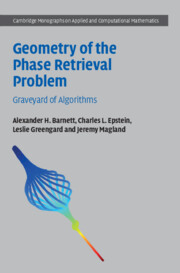Book contents
- Frontmatter
- Contents
- Preface
- Acknowledgments
- 1 Introduction
- Part I Theoretical Foundations
- 2 The Geometry Near an Intersection
- 3 Well-Posedness
- 4 Uniqueness and the Nonnegativity Constraint
- 5 Some Preliminary Conclusions
- Part II Analysis of Algorithms for Phase Retrieval
- Part III Further Properties of Hybrid Iterative Algorithms and Suggestions for Improvement
- References
- Index
4 - Uniqueness and the Nonnegativity Constraint
from Part I - Theoretical Foundations
Published online by Cambridge University Press: 21 April 2022
- Frontmatter
- Contents
- Preface
- Acknowledgments
- 1 Introduction
- Part I Theoretical Foundations
- 2 The Geometry Near an Intersection
- 3 Well-Posedness
- 4 Uniqueness and the Nonnegativity Constraint
- 5 Some Preliminary Conclusions
- Part II Analysis of Algorithms for Phase Retrieval
- Part III Further Properties of Hybrid Iterative Algorithms and Suggestions for Improvement
- References
- Index
Summary
Another constraint often used in the phase retrieval problem to get an essentially unique solution, is the assumption that the unknown is image is real valued, and nonnegative. This assumption alone does not guarantee a unique solution, even up to trivial associates. In this chapter we prove that, if the image is nonnegative, then the phase retrieval problem does generically have a unique solution, up to trivial associates, provided that the autocorrelation image has sufficiently small support. This condition is verifiable from Fourier magnitude data alone. We study the geometry near intersection points of a magnitude torus A and the nonnegative orthant, B+. This naturally leads to a study of the L1-norm on the tangent space of A at the point of intersection, and a criterion for such an intersection to be transversal. The chapter closes with numerical examples examining the failure of transversality.
- Type
- Chapter
- Information
- Geometry of the Phase Retrieval ProblemGraveyard of Algorithms, pp. 85 - 102Publisher: Cambridge University PressPrint publication year: 2022

